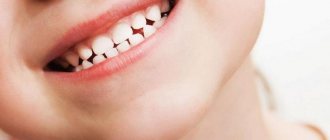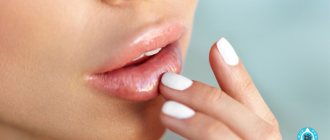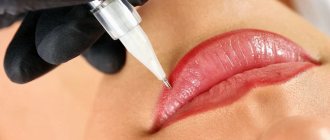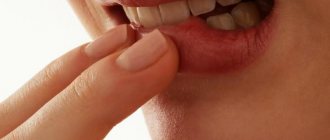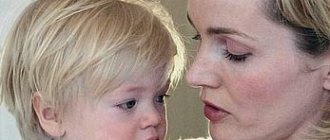Last update: 03/03/2021
Dry lips in a child can turn from a small nuisance into a big problem if care is not taken in time. But it is very easy to ignore this problem - young children may remain silent and not complain, fearing the terrible treatment with pills and injections.
In fact, there are a dozen causes of dry skin. The most common ones seem very simple, but still constantly provoke peeling and cracking of the lips.
How to deal with dry lips in a child?
To care for a child’s lips, only special cosmetics based on natural ingredients, without chemical dyes and fragrances, are suitable. In winter, before going outside, be sure to treat your baby’s lips with a rich hygienic lipstick, which will nourish and protect from the cold, while also lasting long enough.
An alternative to lipstick can be regular baby cream. If you are very dry, you can apply it in a thick layer at night. You can also lubricate your lips with olive or sea buckthorn oil - it leaves a nourishing and protective film on the lips, even if you lick it off.
Balm "La Cree" combines the best of active natural ingredients that soften and heal the skin. This hypoallergenic product can be used for very young children. Active ingredients include: shea butter, almond and castor oils, avocado extract, beeswax, vitamins A and E. This set provides comprehensive care at any time of the year.
Should I see a doctor if my newborn's skin is peeling?
In this situation, you need to act the same way as in all others related to the baby’s health: it’s better to play it safe and go to the doctor one more time than to ignore your doubts and start a problem. In addition, there are several alarming symptoms that clearly indicate the need to consult a specialist:
- The baby is growing, but the peeling is not getting smaller.
- The skin began to peel unevenly, and one or more spots appeared on the baby’s body, where the problem manifested itself more acutely.
- The peeling increased sharply, especially if you did not introduce new foods into complementary foods, did not put new clothes on the baby, or changed anything in his life.
- Not only does the baby's skin peel, but there are also other symptoms of skin diseases - red spots or dots, itching, pimples, blisters and others.
| Our expert Polina Vasilyeva dermatologist |
| Initially, the skin of babies is practically never dry due to its saturation with lipids. But they dissolve under the influence of chemicals (which are found in washing powder, soap, and urine), so peeling and inflammation of the skin in babies is quite common. Dry skin can also become due to health problems, and therefore, if there is severe peeling, be sure to consult a doctor. |
Experts' opinion
According to the results of clinical studies, which involved 50 children aged 0 to 5 years, the products were proven to be highly effective, safe and tolerable for daily skin care of children with mild to moderate forms of atopic dermatitis and during remission, accompanied by a decrease in the quality of life of patients . As a result of therapy, including the use of lip balm, a decrease in the activity of the inflammatory process, a decrease in dryness, itching and flaking was noted.
La Cree Lip Balm has been confirmed to:
- relieves discomfort and dry skin
- restores dry and chapped lips
- moisturizes and protects the delicate skin of the lips from cold and wind
The lack of vitamins can be replenished with the help of children's multivitamin complexes (they differ from adults in composition and dosage), lubricate the lips with vitamins from capsules and, of course, eat more foods rich in vitamins.
To humidify indoor air, you can use special humidifiers or simply place containers of water next to the radiators.
Hygiene and skin care in children of the first year of life in questions and answers
Shaposhnikov Alexey Evgenievich
Dermatologist
April 24, 2021
1. What happens to a baby’s skin after birth?
The first days after birth, children do not look like the pink babies from magazine illustrations. The skin may not look very beautiful for a long time, do not worry, in most cases, changes in the skin are not diseases, they are considered physiological, that is, they do not require treatment, and everything goes away as the child grows. What situations may arise:
- Physiological jaundice of newborns (jaundice coloring of the skin on the 2nd - 3rd day of life disappears by the 7th - 10th day of life).
- Dilated skin capillaries disappear by 1–1.5 years of age.
- Physiological skin catarrh is redness of the skin after removal of lubricant. On the 3rd – 5th day, peeling occurs, which lasts from 2 weeks to 1 – 2 months.
- Milia (sebaceous cysts) are whitish-yellowish nodules 1-2 mm in size, rising above the skin level and appearing mainly on the wings of the nose and on the forehead. Occurs in approximately 40% of newborns. These are sebaceous glands with abundant secretion and clogged excretory ducts. If there are signs of mild inflammation (redness), the nodules can be treated with a 0.5% solution of potassium permanganate. Completely disappear by the first year of life.
- Gneiss (milky crust) - white or light yellow scales on the scalp. They are allergic in nature, so when they appear, you should analyze the diet of the nursing mother and consult a pediatrician. To remove, before bathing you can lubricate the crusts with sterilized vegetable oil, and then carefully remove the softened crusts with a cotton swab or a special brush.
2. How to monitor the condition of your child’s skin?
All skin folds are straightened by hand (thumb and forefinger) and inspected to identify residues of powder, oil, or redness of the skin, etc. You need to start with the neck, then the palms, with each finger examined separately, the elbows and armpits, then the legs, interdigital spaces, popliteal and thigh folds. Particular attention should be paid to the genitals, as irritation often occurs there.
3. What products are usually used for care, are there any special features?
These are special children's cosmetics: powder, oil, cream. The cream, as the most oily, is used for severe dry skin, but not in the folds, because may cause diaper rash. If there is no pronounced dryness of the skin, it is enough to use oil; it can also be used to treat folds. If the skin folds are deep, it is better to use powder. The simultaneous use of oil (cream) and powder is not allowed, as the resulting lumps accumulate in the folds of the skin and cause redness and irritation. There is no need to completely cover the child with oil or cream, this inhibits the respiratory function of the skin. It is enough to treat problem areas.
4. What detergents are best to use and how to bathe a child?
Regular baby soap used in soft water can significantly dry out the skin, so it is better to use medicinal cosmetic cleansers. For the first 6 months of life, it is necessary to bathe every day, preferably in the evening, before the last feeding. The water temperature is 37 degrees, in the newborn period the water should be boiled, for older children it should be heated and cold, and they can be bathed every other day. If possible, it is better not to use hot tap water, especially if you have skin problems; it has an irritating effect due to various additives. It is better not to use washcloths, but washing with soap once a week is enough.
5. What herbs are best to use?
The golden rule is not to mix herbs, this way, if a problem occurs, you can always identify the “culprit”. In our region, it is better to use calendula (disinfectant, anti-itch), sage (anti-inflammatory), violet (disinfectant), viburnum bark (disinfectant, anti-inflammatory). Previously widely used string, chamomile, celandine in the soft water of our city aggravate dry skin and it is better not to use them at all.
To prepare a decoction for bathing, boil 100 g of herbs over low heat for 5-10 minutes. and diluted in 10 liters of water. The grass should be in a gauze bag. Bathing lasts about 10 minutes, every other day, for a course of 10-15 procedures.
6. How to properly wash and care for the skin under a diaper?
The diaper should be changed at least every 3-4 hours; at night, if the baby sleeps peacefully, this period can be increased. When breastfeeding, bowel movements can occur quite often, and of course, every time you do this, you need to wash the baby and change the diaper.
At any age, it is necessary to arrange “air baths” when changing clothes, so that the child can be without a diaper for some time, from 15 minutes and the more, the better. This is not only good for the skin, but is also an excellent hardening procedure.
You can wash your baby under the tap, not forgetting that girls are washed from front to back. To cleanse the skin, it is better to use liquid baby cleansers that have a neutral pH and do not dry out the skin. It is better not to use wet wipes all the time, leaving them for situations when the baby needs to be changed outside the home.
You can apply a protective baby cream with zinc under the diaper, which will create a thin, breathable barrier, preventing redness and irritation. Protective baby cream can also have an antibacterial effect.
7. What skin problems most often occur in infants?
If a small pink rash appears on the back or back of the head, it is most likely prickly heat caused by overheating. To prevent heat rash, a child should be dressed according to the season, not wrapped up, and monitor the temperature in the room where the child sleeps.
Diaper rash is manifested by bright redness of the skin of the buttocks and inguinal folds. To prevent diaper rash, it is necessary to properly and regularly cleanse the baby’s skin, thoroughly dry and ventilate the skin and folds during air baths, and apply moisturizers containing drying agents (zinc oxide, talc). In this case, you need to use diapers with caution and for a short time, maximizing the air baths.
Often diaper rash in newborns occurs as a result of fungal infection of the skin and mucous membranes (thrush) . In this case, consultation with a dermatologist and special treatment are necessary.
Pyoderma manifests itself as small superficial pustular rashes. Often found in young children and caused by staphylococci and streptococci, it is an infectious skin disease. If a child develops pustular rashes, it is necessary to consult a dermatologist.
Allergic dermatitis is the general name for redness, spots, peeling and rashes on the skin of an allergic nature. Allergic dermatitis is not a skin disease, it is a manifestation of an allergic reaction when, due to the immaturity of the immune and digestive system, some substances entering the body are not absorbed and provoke irritation. Can be food or contact. If allergic dermatitis appears, you need to consult a pediatrician who will help you choose a diet and advise how to relieve the symptoms.
Prevention includes long-term breastfeeding, proper introduction of complementary foods, and a hypoallergenic lifestyle. If parents are allergic to anything, or they themselves had skin problems in childhood, and currently have dry skin, or have skin diseases, then it is necessary to be more attentive to prevention, because negative tendencies are often inherited.
8. What to do if skin problems do appear and tend to persist?
If changes in the skin become persistent, itching appears, the child becomes restless, be sure to visit a dermatologist, especially in the following cases:
- Affects 20% of the skin surface, or 10%, including the eyelids, hands, and skin folds.
- Severe peeling and redness of the skin.
- Attachment of infectious complications on the skin.
- In diagnostically unclear cases.
Constantly dry lips in a child may be a symptom of a disease
If your baby’s lips are constantly dry: in any weather, under any diet, cosmetics do not help them, perhaps this is how the body indicates the presence of a more serious disease.
- Problems with the thyroid gland.
- Diabetes mellitus is also accompanied by increased thirst.
- With dryness, cracking and the appearance of various crusts - fungus, psoriasis.
- Autoimmune diseases are a complex of diseases usually associated with damage to the skin and bone tissue. They are based on the body's immune reaction against itself.
In these cases, it is necessary to consult a doctor for a serious diagnosis.
Sources:
- I.I. Ryumina, V.V. Zubkov, Newborn skin care, Healthy Child magazine, 2017
- V.V. Chebotarev, N.V. Chebotareva, M.S. Askhakov, E.V. Bronnikova, Sensitive skin: causes, methods of therapy, journal Medical Bulletin of the North Caucasus, 2015
- Drobinskaya, A. O. Fundamentals of pediatrics and hygiene of children of early and preschool age / A. O. Drobinskaya. - Moscow: Higher School, 2016. - 400 p.
Photos of diathesis
Photo album on the disease
Does it often happen that a baby's skin peels?
Let's put it this way: if you find a baby whose skin has never peeled off in the first year of life, you will surprise not only us, but, perhaps, all pediatricians in the world. In most cases, peeling is a completely natural process that is associated with a sharp change in environmental conditions. Sometimes the baby’s skin even peels off; especially problem areas for a newborn are the feet, hands, and head.
Just think about it: over the previous nine months, the child has never encountered a situation where the temperature around him differs from his own. His skin was constantly moisturized and never came into contact with air. Finally, she did not know sunlight and was not exposed to ultraviolet radiation for a second. Now you can imagine the mess your beloved baby got into when he decided to be born 
Typically, a baby's skin will peel because it needs time to adapt to life outside the womb. But there are other factors that lead to this problem.
| Our expert Polina Vasilyeva dermatologist |
| If a newborn's skin peels, this is a physiological phenomenon and is normal. This condition can occur about a day after the birth of the baby and lasts for 3–4 weeks. Despite the fact that this condition is considered normal, it is worth seeing a doctor to rule out congenital ichthyosis and other skin diseases. |
Diagnosis and treatment of diathesis
The doctor determines how to treat diathesis on the cheeks of a child depending on the diagnosis performed. It includes a general urine test, general and biochemical blood tests, an immunological examination, and a stool test for dysbacteriosis. In case of lymphatic-hypoplastic diathesis, additional examinations are required: radiography of the respiratory organs, ultrasound of the liver, lymph nodes, spleen and adrenal glands.
How to treat diathesis in children under one year of age and older:
- Follow the diet and feeding schedule prescribed by your doctor.
- Introduce complementary foods no earlier than 6 months.
- Limit consumption of cow's milk.
- Enrich your diet with vitamins.
- Use prescribed medications: antihistamines, absorbents, vitamins, antipruritics.
As a local treatment, an ointment made according to the original recipe “PsorMak” is used. It does not contain hormones or other harmful components, and contains only natural ingredients that are gentle on the skin.
If in childhood a child undergoes a course of effective treatment for diathesis, then he has every chance of not encountering complications and being absolutely healthy in adulthood. Here it is important to contact a specialist in time. The PsorMak clinic practices an individual approach to the treatment of each patient, developing not only a treatment regimen, but also a diet, as well as a prevention program.
Contact us through the form on the website or by calling +7 (495) 150-15-14. We will help you form a correct understanding of the disease itself and its treatment at all stages.
HOW TO MAKE AN APPOINTMENT at the PsorMak Institute for Healthy Skin
1. Click the button you see below -
Make an appointment
2. Fill in the fields in the form that appears. Be sure to check the correct phone number so that our specialist can reach you. After filling out, click on the “Submit” button.
3. Wait for our specialist to call. He will answer any of your questions and agree on the date and time of your visit to PsorMak.
The initial appointment includes:
- Visual examination , which will allow the specialist to get a general understanding of the condition of your skin and the pathology itself.
- Collecting anamnesis - finding out information about the development of the disease, living conditions, previous diseases, operations, injuries, chronic pathologies, allergic reactions, heredity, etc. Together with a general examination, this allows you to make a fairly accurate diagnosis and choose a method of treatment and/or prevention.
